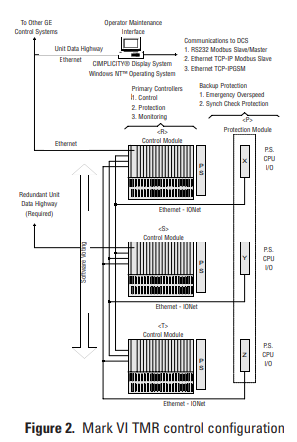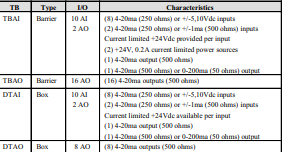
GESPEEDTRONIC™ Mark VI Turbine Control System
own” IONet.
Data from the VCMI cards in each of the three
Control Modules is then exchanged and voted
prior to transmitting the data to the main
processor cards for execution of the application
software. Output voting is extended to the turbine with three coil servos for control valves and
2 out of 3 relays for critical outputs such as
hydraulic trip solenoids. Other forms of output
voting are available, including a median select
of 4-20ma outputs for process control and 0-
200ma outputs for positioners.
Sensor interface for TMR controls can be either
single, dual, triple redundant, or combinations
of redundancy levels. The TMR architecture
supports riding through a single point failure in
the electronics and repair of the defective card
or module while the process is running. Adding
sensor redundancy increases the fault tolerance
of the overall “system.” Another TMR feature is
the ability to distinguish between field sensor
faults and internal electronics faults.
Diagnostics continuously monitor the 3 sets of
input electronics and alarms any discrepancies
between them as an internal fault versus a sensor fault. In addition, all three main processors
continue to execute the correct “voted” input
data. (See Figure 2.)
I/O Interface
There are two types of termination boards. One
type has two 24-point, barrier-type terminal
blocks that can be unplugged for field maintenance. These are available for Simplex and
TMR controls. They can accept two 3.0 mm2
(#12AWG) wires with 300 volt insulation.
Another type of termination board used on
Simplex controls is mounted on a DIN rail and
has one, fixed, box-type terminal block. It can
accept one 3.0 mm2 (#12AWG) wire or two 2.0
mm2 (#14AWG) wires with 300 volt insulation.
I/O devices on the equipment can be mounted
up to 300 meters (984 feet) from the termination boards, and the termination boards must
be within 15 m (49.2’) from their corresponding I/O cards. Normally, the termination
boards are mounted in vertical columns in termination cabinets with pre-assigned cable
lengths and routing to minimize exposure to
emi-rfi for noise sensitive signals such as speed
inputs and servo loops.
General Purpose I/O
Discrete I/O. A VCRC card provides 48 digital
inputs and 24 digital outputs. The I/O is divided between 2 Termination Boards for the contact inputs and another 2 for the relay outputs.
(See Table 1.)
Analog I/O. A VAIC card provides 20 analog
inputs and 4 analog outputs. The I/O is divided
between 2 Termination Boards. A VAOC is dedicated to 16 analog outputs and interfaces with
1 barrier-type Termination Board or 2 box-type
Termination Boards. (See Table 2.)
Temperature Monitoring. A VTCC card provides interface to 24 thermocouples, and a
VRTD card provides interface for 16 RTDs. The
input cards interface with 1 barrier-type


reduced by eliminating peripheral instrumentation. The VTUR card is designed to integrate
several of the unique sensor interfaces used in
turbine control systems on a single card. In
some applications, it works in conjunction with
the I/O interface in the Backup Protection
Module described below.
Speed (Pulse Rate) Inputs. Four-speed inputs
from passive magnetic sensors are monitored by
the VTUR card. Another two-speed (pulse rate)
inputs can be monitored by the servo card
VSVO which can interface with either passive or
active speed sensors. Pulse rate inputs on the
VSVO are commonly used for flow-divider feedback in servo loops. The frequency range is 2-
14k Hz with sufficient sensitivity at 2 Hz to
detect zero speed from a 60-toothed wheel. Two
additional passive speed sensors can be monitored by “each” of the three sections of the
Backup Protection Module used for emergency
overspeed protection on turbines that do not
have a mechanical overspeed bolt. IONet is
used to communicate diagnostic and process
data between the Backup Protection Module
and the Control Module(s) including cross-tripping capability; however, both modules will initiate system trips independent of the IONet.
(See Table 4 and Table 5.)
Synchronizing. The synchronizing system consists of automatic synchronizing, manual synchronizing, and backup synch check protection. Two single-phase PT inputs are provided
Application Specific I/O
In addition to general purpose I/O, the Mark
VI has a large variety of cards that are designed
for direct interface to unique sensors and actuators. This reduces or eliminates a substantial
amount of interposing instrumentation in
many applications. As a result, many potential
single-point failures are eliminated in the most
critical area for improved running reliability
and reduced long-term maintenance. Direct
interface to the sensors and actuators also
enables the diagnostics to directly interrogate
the devices on the equipment for maximum
effectiveness. This data is used to analyze device
and system performance. A subtle benefit of
this design is that spare-parts inventories are
on the TTUR Termination Board to monitor
the generator and line busses via the VTUR
card. Turbine speed is matched to the line frequency, and the generator and line voltages are
matched prior to giving a command to close the
breaker via the TTUR.
An external synch check relay is connected in




























































































































